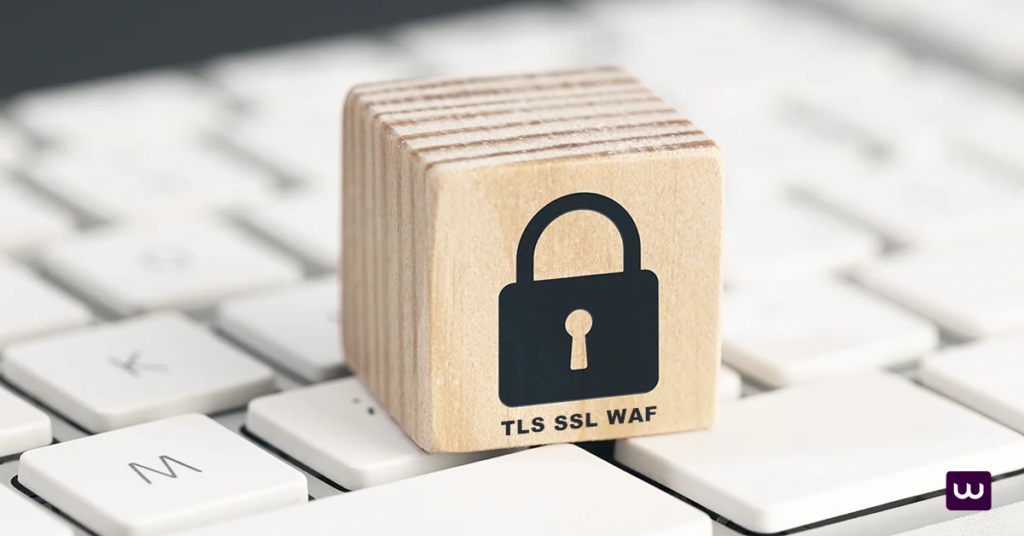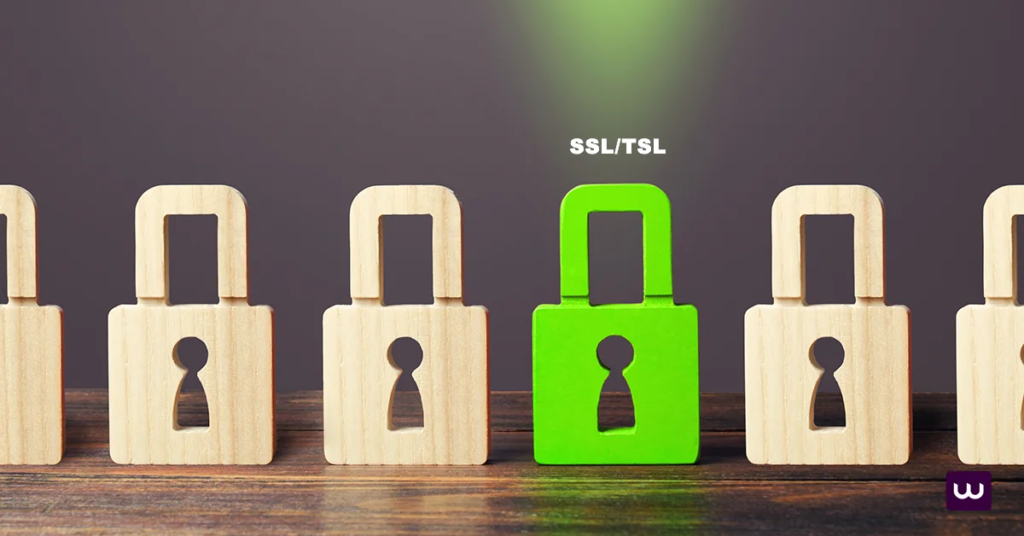
In today’s digital world, website security is vital for trust and credibility. Utilizing a certificate manager to secure an Application Load Balancer (ALB) with an SSL certificate is crucial for ensuring that all traffic is securely directed. Using WAF, SSL and TLS technologies ensures encrypted data transmission and vigilant traffic monitoring, effectively protecting sensitive information.
What is Web Application Firewalls (WAF)

What is WAF?
A Web Application Firewall (WAF) is a shield between your web services and threats. It monitors and filters HTTP traffic to and from a web application. The main purpose of a WAF is to protect your website from SQL injection, cross-site scripting and other vulnerabilities that can compromise your web app or services.
Definition and purpose
A WAF is a security layer to protect web applications by monitoring and filtering HTTP traffic. It’s a barrier that prevents malicious traffic from reaching your target applications and web services. By analyzing incoming requests a WAF can identify and block malicious activities and keep your web application safe.
Types of WAFs
Network-based WAFs: Hardware based and on-premises. High speed but expensive.
Host-based WAFs: Software based and integrated into application code. Flexible but resource hungry.
Cloud-based WAFs: Hosted in the cloud. Easy to deploy and scalable. Cost effective and low maintenance.
How WAF protects your web browsers
WAFs protect your web services through two primary functions:
Monitoring and filtering traffic
A Web Application Firewall (WAF) meticulously monitors and filters web traffic to identify anomalies, effectively blocking malicious requests before they reach your web application, for example, thereby ensuring only legitimate traffic is permitted.
Blocking malicious requests
When a WAF detects a threat it blocks the malicious request from accessing your web app or services. This proactive approach keeps your web application safe and secure.
Choosing the right WAF
Choosing the right WAF for your web services involves:
Considerations and WAF rules
Security needs: What threats does your web application faces and which WAF can address those vulnerabilities.
Budget: How much are you willing to spend on a WAF solution. Consider initial cost and ongoing maintenance.
Scalability: Can the WAF grow with your web services as your needs change.
Ease of use: Look for a WAF that is easy to configure and manage so your IT team doesn’t have to worry.
WAF solutions
Here are some popular WAF solutions:
AWS WAF: Cloud based and integrates with Amazon Web Services.
Cloudflare WAF: Easy to use and robust features.
Imperva WAF: For on-premises and cloud based applications.
Now that you know and understand the Web Application Firewall, you can secure your web services from many cyber threats.
What is SSL and TLS

What is SSL/TLS?
Definition and history
SSL (Secure Sockets Layer) and TLS (Transport Layer Security) are the protocols that encrypt the data between a user’s browser and your server. SSL was the original protocol developed in the mid 90s to secure internet communications. Over time TLS emerged as an improved version with more security features. Today TLS is the industry standard protocol to secure online information.
How it works
SSL/TLS works by establishing a secure connection between a client and a server. When a user visits your website, their browser requests a secure connection. To ensure secure connections, it is crucial to configure the security settings for your Application Load Balancer (ALB) properly, particularly by enforcing HTTPS access over the ALB’s DNS Name. Your server responds to http request by sending a digital certificate which contains a public key. The browser verifies this certificate and uses the public key to encrypt the data. Only your server can decrypt the data using a private key so the information remains confidential.
Why SSL/TLS for website security
Data encryption
SSL/TLS encrypts the data between your website and users so it’s unreadable to anyone else. This encrypts sensitive information like login credentials and payment details from being intercepted by hackers. By having SSL/TLS you ensure your own server decrypts users’ data is secure during transmission.
Authentication and trust
SSL/TLS also provides authentication, verifies your website’s identity. When users see a link with a padlock icon in their browser’s address bar they know your site is secure and trustworthy. This visual cue builds trust in your services so users can engage with your website without fear of data breach.
Installing SSL/TLS on your website
Get an SSL certificate (Secure Sockets Layer)
To install SSL/TLS you need to get an SSL certificate from a trusted Certificate Authority (CA). This certificate is proof of your website’s authenticity. You can choose from different types of certificates like https, Domain Validation (DV), Organization Validation (OV) or Extended Validation (EV) depending on compliance requirements and your security needs.
Configure your server
After getting an SSL certificate you need to configure your server to support SSL/TLS. An application load balancer can help manage HTTP and HTTPS traffic, ensuring secure connections to your applications. This involves installing the certificate and updating your server settings to enable HTTPS. You should also redirect HTTP traffic to HTTPS so all data exchange happens over a secure connection. Regularly update your SSL/TLS configurations to maintain optimal security.
TLS SSL WAF

Why WAF and SSL/TLS?
Integrating Web Application Firewalls (WAF) with SSL/TLS protocols provides comprehensive security for your website, ensuring robust protection for web services by encrypting data transmission and effectively monitoring and filtering network traffic to safeguard customers against cyber threats.
More security
By having TLS SSL WAF you have a multi-layered defense. WAF monitors and filters incoming traffic, blocks malicious requests. SSL/TLS encrypts the data between the user’s browser and your server. This combination secures both the data and the application from cyber threats.
All-around protection
TLS SSL WAF gives you all-around protection by covering different security aspects. WAF protects your web application from SQL injection and cross-site scripting. SSL/TLS keeps sensitive information like login credentials and payment details confidential. This dual approach creates a secure environment for your users.
How to integrate
To install TLS SSL WAF follow these steps to integrate smoothly and securely.
WAF with SSL/TLS
Choose a WAF: Choose a WAF that supports SSL/TLS integration. Make sure it fits your security needs and budget.
Get an SSL certificate: Get a valid SSL certificate from a trusted CA. This certificate will verify your website and enable encrypted connections.
Configure your server: Install the SSL certificate on your server. Update your server settings to enable HTTPS. This is the most important step for secure communication between your web application and users.
WAF with SSL/TLS: Configure the WAF to work with SSL/TLS. This involves setting up the WAF to inspect encrypted traffic. WAF should decrypt incoming data, analyze it for threats and re-encrypt it before forwarding it to your web application.
Client Certificate Authentication: Add more security by using Client Certificate Authentication. This will verify the user accessing your web application. This will add an extra layer of protection by ensuring only authorized users can access sensitive information.
Testing
Security testing: Use automated scanners and manual testing to test your WAF and SSL/TLS integration. These will help you identify vulnerabilities and if your security is working as expected.
Performance monitoring: Monitor your web application regularly. Check for any latency or performance issues that may arise from the integration. Fix these issues as soon as possible to maintain smooth user experience.
Client Certificate Authentication: Verify that Client Certificate Authentication is working as expected. Make sure only authorized users can access your web application. Update and manage client certificates regularly.
By following these steps you can install TLS SSL WAF and have setup a secure and smooth environment for your users. This application layer will not only protect your web application but also build user trust and confidence in your mobile applications and services.
Common Issues and Solutions

WAF issues
False positives
When you install a Web Application Firewall (WAF) you might encounter false positives. These are when the WAF misidentifies legitimate traffic as malicious. This will disrupt user experience and block genuine users from accessing your website. To minimize false positives you need to fine tune your WAF rules and review its logs regularly. By doing so you ensure the WAF can differentiate between malicious and legitimate requests.
Performance issues
Performance issues will arise when you install a traditional WAFs. The additional layer of security will slow down your website’s response time. This is because the WAF will inspect each request before it reaches your server. To fix this you should optimize your WAF configuration and make sure it’s efficient. Consider using a cloud based WAF solution which can offer better scalability and performance.
SSL/TLS issues
Certificate management
Managing SSL/TLS certificates is challenging. You need to ensure your certificates are valid and up-to-date. Expired certificates will show you security flaws, warnings and loss of user trust. To avoid this keep track of your certificate expiration dates and renew them as soon as possible. Automating the renewal process will help you maintain continuous security without manual intervention.
Compatibility issues
Compatibility issues will arise when you implement SSL/TLS. Some older browsers or devices may not support the latest encryption protocols. This will prevent users from accessing your website securely. To fix this configure your server to support multiple TLS versions while prioritizing the most secure ones. Test your website’s compatibility with different browsers and devices regularly to ensure smooth user experience.
Solutions and best practices
Regular updates
Regular updates are key to securing your WAF and SSL/TLS implementation. Keep your software and security protocols up-to-date to protect against new threats. By doing so you will make your website resilient to new vulnerabilities and attack vectors.
Monitoring and maintenance
Monitoring and maintenance is key to security management. Review your WAF logs and SSL/TLS configurations regularly to find issues. Implement automated monitoring tools to detect anomalies and respond to threats in real-time. By being proactive you can protect your website and have a secure environment for your users.
Test Your Website

Security testing tools
Automated scanners
Automated scanners are a quick and easy way to test your website’s security. These tools will scan your site for vulnerabilities and generate reports. They will find common issues like outdated software, weak passwords and misconfigured settings. Using automated scanners will help you quickly identify areas to focus on.
Manual testing techniques
While automated scanners are useful manual testing techniques will give you a deeper insight into your website’s security posture. You can simulate real world attack scenarios to find hidden vulnerabilities. Techniques like penetration testing and ethical hacking will allow you to test your site from an attacker’s perspective. This hands on approach will help you understand the weaknesses and how to fix them.
Test results
Understanding the vulnerabilities
Once you have your test results it’s important to understand the vulnerabilities found. Each vulnerability is different in terms of risk to your website. Some will allow unauthorized access while others will lead to data breaches. Categorize these vulnerabilities so you can prioritize which one to fix first.
Fixing vulnerabilities
After you’ve identified the vulnerabilities you need to prioritize the fixes based on severity and impact. Start with high risk vulnerabilities that can cause significant damage if exploited. Apply patches, update software and adjust configurations to mitigate the risks. By fixing vulnerabilities systematically you will strengthen your website’s security and protect your users’ data.
Regular security testing and analysis is key to having a secure website. By using both automated and manual testing you will have a full understanding of your site’s security posture. Interpreting test results and prioritizing fixes will ensure you fix vulnerabilities effectively and have a secure environment for your users.
Future of Website Security

Emerging technologies
AI and machine learning
Artificial Intelligence (AI) and machine learning is changing website security. These technologies will analyze huge amounts of data to find patterns and detect anomalies. By doing so they will predict potential threats and respond in real-time. You can use AI to automate threat detection and response, reduce time to mitigate risks. Machine learning algorithms will get better and better as new threats emerge. This adaptive approach will make your website more resilient to advanced attacks.
Quantum encryption
Quantum encryption is a game changer in digital security. Unlike traditional encryption methods quantum encryption uses the principles of quantum mechanics to secure the data. It’s unbreakable by making it impossible for hackers to intercept or decrypt the data. As quantum computing becomes more mainstream you should consider incorporating quantum encryption into your security strategy. This will keep your sensitive data safe from the most advanced attacks.
Emerging threats
New attack vectors
Attackers will always find new ways to exploit vulnerabilities. Phishing, ransomware, zero day exploits are just a few examples. You need to stay up to date with these emerging threats to protect your website. Update your security protocols and educate your team on the latest attack methods. By understanding new attack patterns and vectors you can take proactive measures to secure your web services.
Adaptive security
Adaptive security is key to responding to the changing threat landscape. This means continuously monitoring your website for suspicious activity and adjusting your defenses accordingly. Adaptive security will allow you to respond in real-time and minimize damage. You can use tools like intrusion detection systems and behavioral analytics to enhance your adaptive security. By being flexible you will make your website more resilient to emerging threats.
To stay ahead of future of website security you need to adopt emerging technologies and understand emerging threats. By using AI, machine learning and quantum encryption you can strengthen your website’s defenses. Also staying up to date with new attack vectors and adaptive security will help you have a strong security posture.
Minimum TLS Version and Why It Matters

What is Minimum TLS Version (Transport Layer Security)
Definition and importance
Minimum TLS version refers to the lowest version of the TLS protocol your server will accept for secure connections. Setting a minimum TLS version is important because older versions have vulnerabilities that attackers can exploit. By enforcing a higher minimum TLS version you will only allow modern and secure protocols to be used which will strengthen your website’s security. This will protect your sensitive data and user trust.
How to do it
To configure minimum TLS version on your server you need to update your server’s settings to reject connections using old protocols. Follow these steps:
Access your server’s configuration files: Find the files where your server’s SSL/TLS settings are defined. These files will vary depending on your server software.
Set the minimum TLS version: Edit the configuration files to set the minimum TLS version. For example TLS 1.2 or TLS 1.3 depending on your security requirements.
Update the cipher suite: Make sure your server supports a secure cipher suite. Remove weak ciphers and add strong ones like AESGCM. This will ensure the entire communication is encrypted and secure.
Test the configuration: After you made the changes test your server to see if it only accepts connections using the specified minimum TLS version and cipher suite. Use online tools or command-line utilities to check the server’s response.
By doing this you will have configured your server to support minimum TLS version.
Client Certificate Authentication
How it enhances security
Client Certificate Authentication adds an extra layer of security by requiring users to present a valid certificate before accessing your website. This will verify the client’s identity and only allow authorized users to connect. It will complement the server’s authentication and strengthen the overall security. By using Client Certificate Authentication you will protect your sensitive resources and prevent unauthorized access.
How to do it
To use Client Certificate Authentication follow these steps:
Create Client SSL Profile: Create a Client SSL Profile on your server. This profile will define the requirements for client certificates including minimum TLS version and cipher suite.
Get client certificates: Distribute client certificates to authorized users. These certificates will be proof of identity and must be issued by a trusted Certificate Authority.
Configure the server: Update your server’s settings to require client certificates for authentication. Make sure the server will check the validity of each certificate presented by clients.
Test it: Test the Client Certificate Authentication. Test with different client certificates to see if only valid ones are accepted.
Monitor and maintain: Regularly check the authentication logs and update client certificates as needed. This will ensure your security is always up to date.
By doing this you will have Client Certificate Authentication on your website and a robust defense against unauthorized access to your domain via reverse proxy or server.
Securing your website with a Web Application Firewall (WAF) and SSL/TLS is a must. These will protect your site from cyber threats and data integrity. WAF technology will monitor and filter traffic and SSL/TLS will encrypt the data exchange. Having a valid SSL certificate is required for authentication and trust. You should prioritize these security measures to have a safe online environment. Regular updates and monitoring is important for ongoing protection. By doing this you will secure your website and build user trust.




